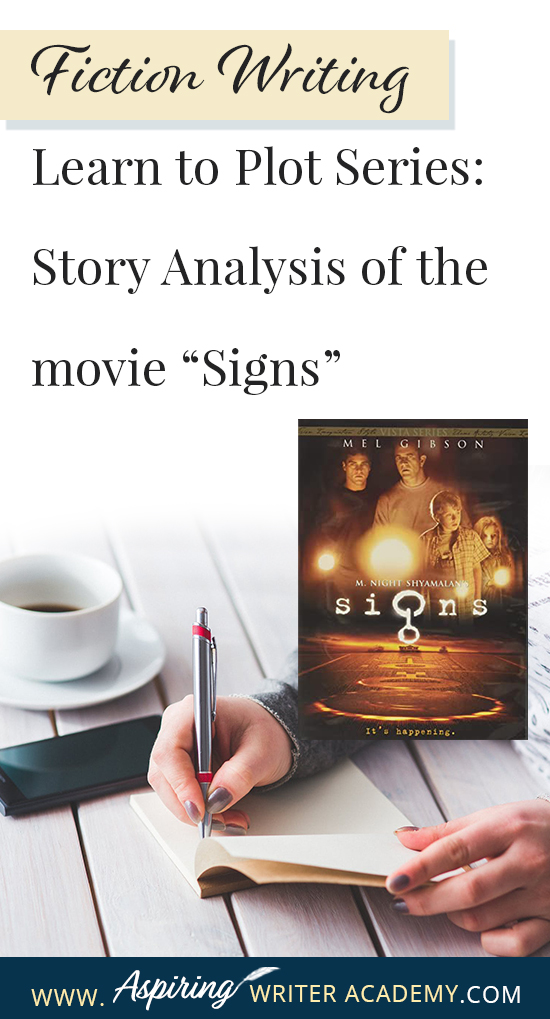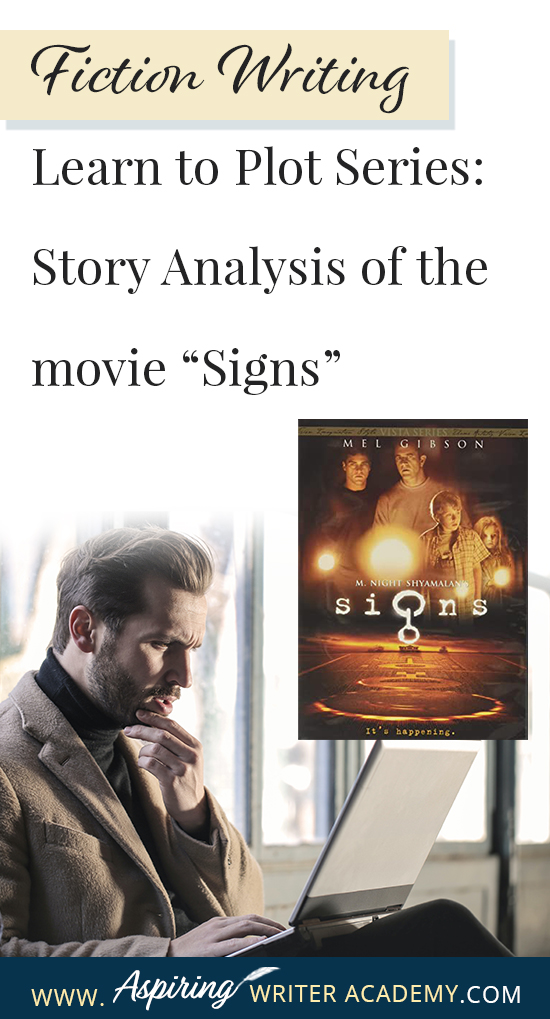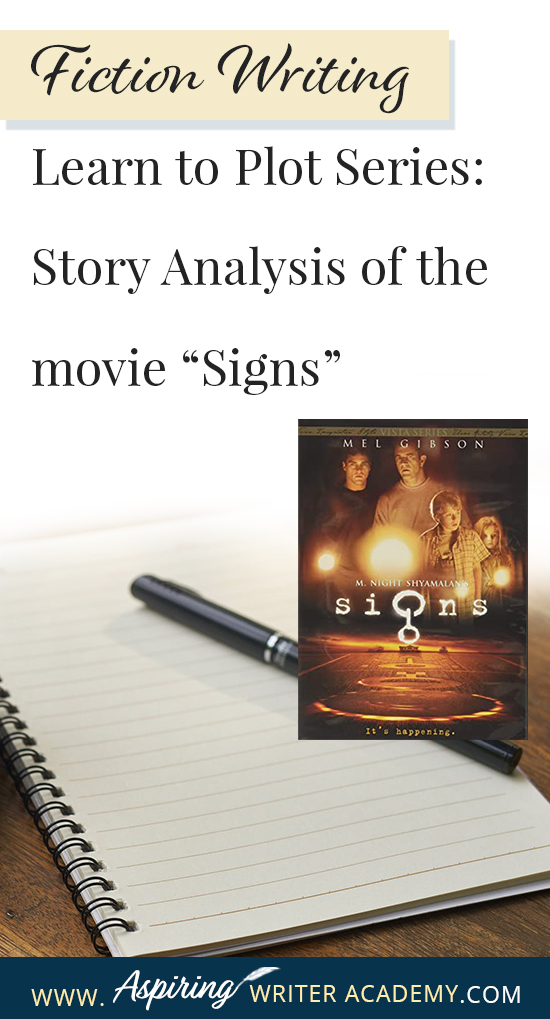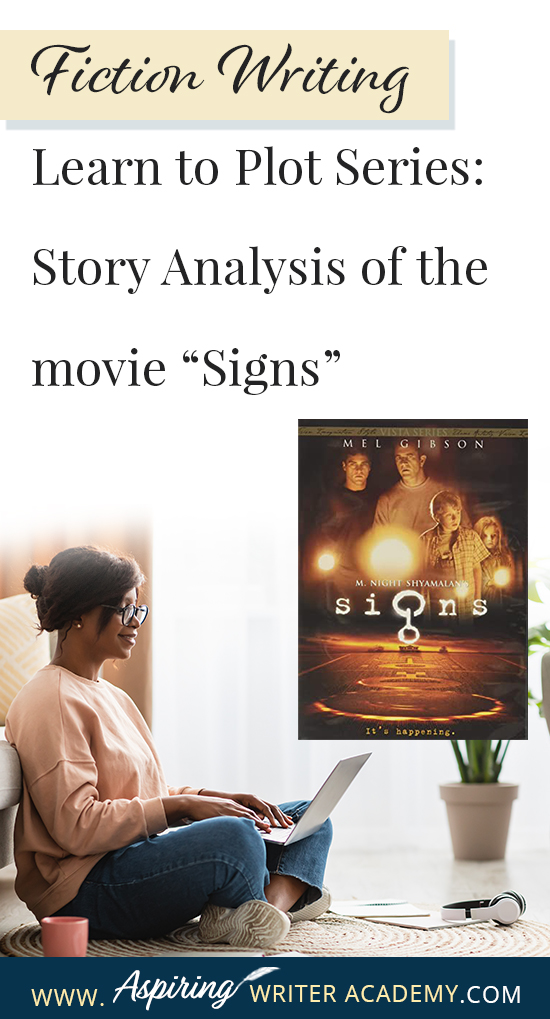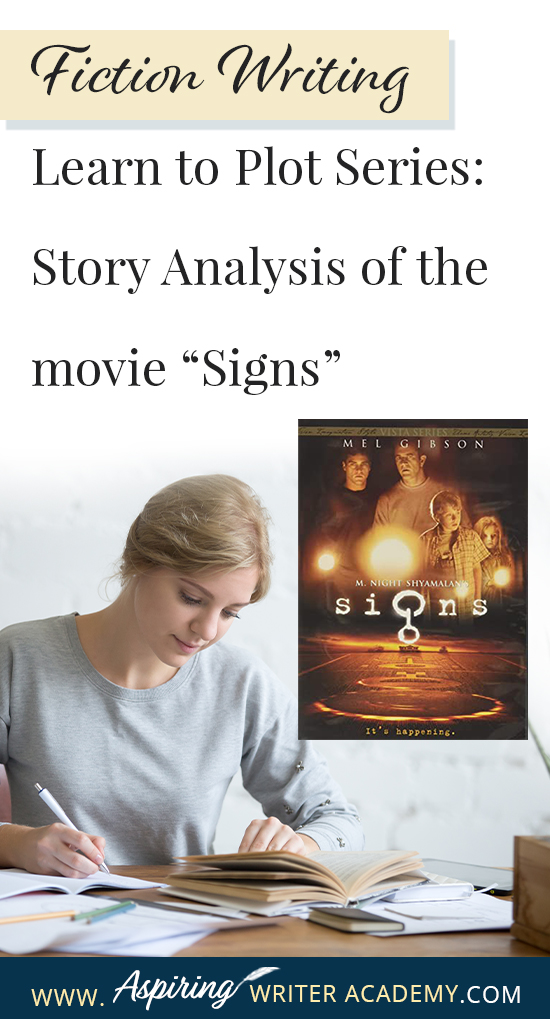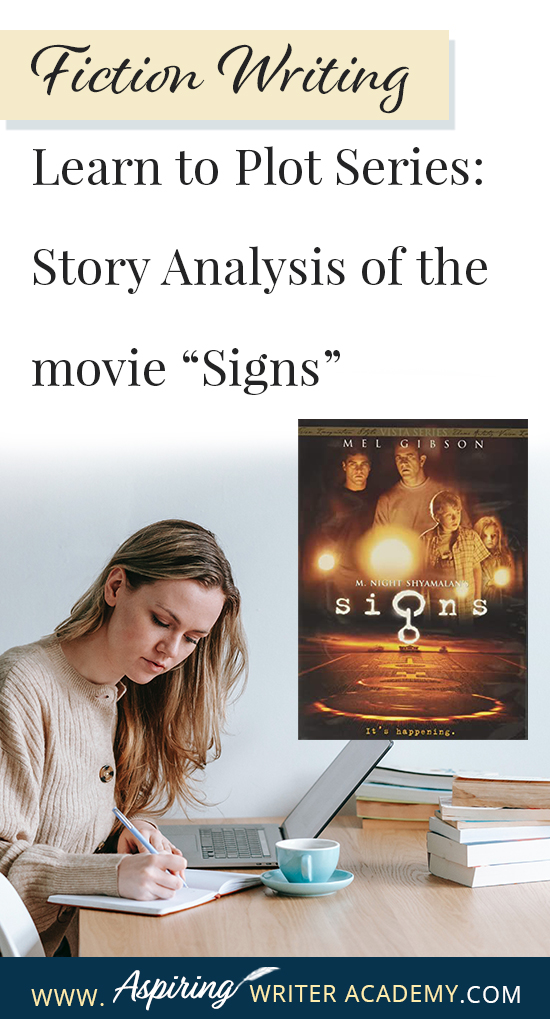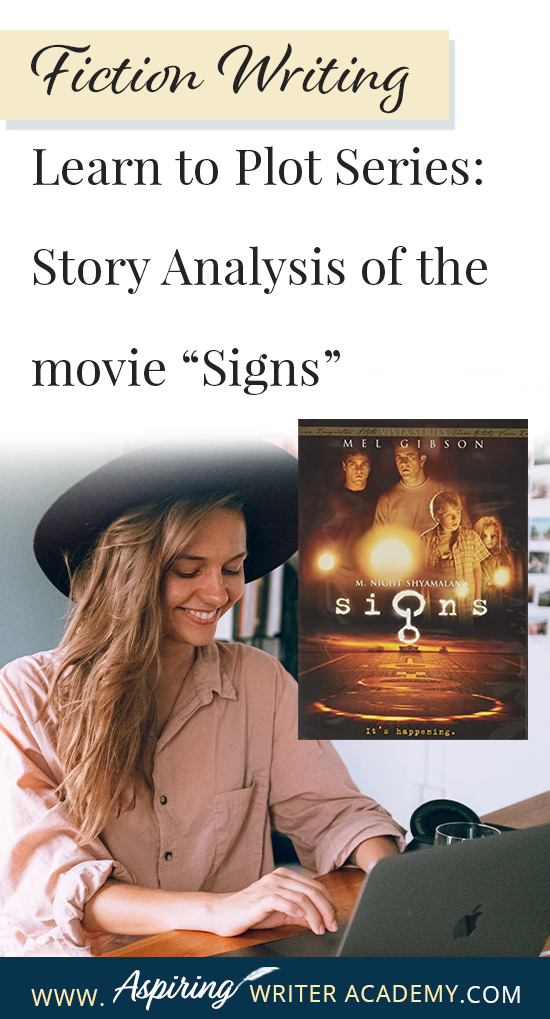Learn to Plot Fiction Writing Series: Story Analysis of the movie “Signs”
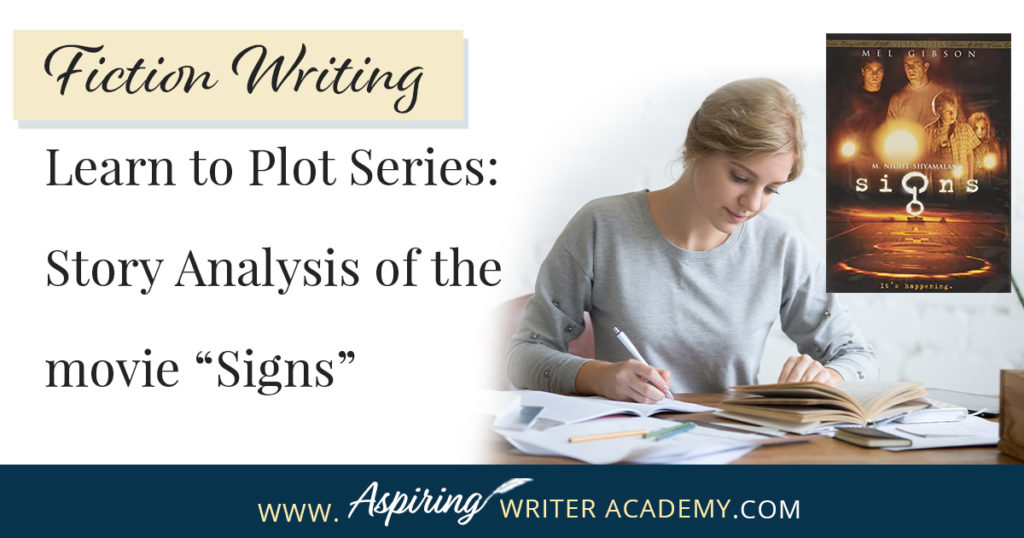
The best way to learn story structure is to analyze good stories. Can you readily identify each plot point in every movie you see or book you read? Or do terms like ‘inciting incident,’ ‘midpoint reversal,’ and ‘black moment’ leave you confused?
In our Learn to Plot Fiction Writing Series: Story Analysis of the movie “Signs” we will show you how to recognize each element and provide you with a Free Plot Template so you can draft satisfying, high-quality stories of your own.
But why this movie?
Some stories remain with us, no matter how long ago they were written. Most likely because those stories touched our hearts and our emotions in a meaningful way. Some call these unforgettable stories “classics.” Whether this movie is a classic or not is a matter of opinion, but never discount the value of an older story when studying story structure.
The 2002 movie, starring Mel Gibson, tells the tale of a former Episcopal priest (Graham Hess) and his family, who find a 500-foot extraterrestrial crop circle in their cornfield in rural Pennsylvania. As the phenomena spreads worldwide, they must deal with the threat of an alien invasion while still reeling from a personal tragedy which has caused Graham to question his beliefs.
The movie was written/directed by M. Night Shyamalan and also stars Joaquin Phoenix, Rory Culkin, and Abigail Breslin.
Shop on Amazon: https://amzn.to/3CqBQsp
One of the best ways to learn story structure is to analyze as many movies and books as you can. We suggest you watch movies because you can see the whole story played out before you in approximately two hours, which may be quicker than reading an entire book.
We also suggest that you watch the movie with our Free Downloadable Solid Story Structure Plot Template beside you so that you can write down each plot point as soon as you see it appear on the screen. Do this twenty or so more times and you will soon be on your way to becoming a story structure expert!
Click to download our free Solid Story Structure Plot Sketch Template to help you analyze books or movies, and plot stories of your very own.
Warning! This post contains story spoilers. If you have not already seen the movie and do not want any story spoilers the first time around, you might want to watch the movie for enjoyment then watch it a second time using this post to help you identify each story element.
ACT I
Opening Scenes:
What do the opening scenes of “Signs” accomplish? How do they serve to set up the story?
- Setting.
First, you need to establish the ‘ordinary world.’ When the movie opens, we see a cornfield and children’s playground equipment in a yard viewed from the upper window of a two-story house. It is obviously a rural setting. Inside, a picture frame showing a family of four rests on top of a dresser. And on the wall, is the faded outline of where a cross was once hung, which makes us question—why was it removed?
- First scene opens with an interesting situation (initial problem).
The story opens with the characters facing an initial problem, which acts as a hook, to grab the reader’s attention. This isn’t the main problem yet, but a situation or event to get the story rolling.
Graham Hess (played by Mel Gibson) gets out of bed and hears his young daughter, Bo, scream. Graham and his brother, Merrill, rush to the children in the cornfield. Graham’s son, Morgan, points to a crop circle and says, “I think God did it.” Graham looks, and the camera zooms out to reveal they are standing in a pattern of three giant crop circles. This is the introduction to something mysterious. The characters do not know what is going on.
- Introduction of the main characters, their personalities, and the character’s relationships with one another. Also hint at the internal (relationship) conflict and escalating external conflict (concerning the mysterious opening situation.)
- One of their two dogs pees on the kitchen floor. They think the animal might be sick. But then the dog lashes out at the kids and when Morgan defends his sister, Bo, with a kitchen knife, the dog is killed. Word has it that other animals in the area have been acting aggressive, as if they smell a predator. (Foreshadowing.)
- Graham calls police officer Paski and she casually calls him “Father” during the conversation. He asks her to stop calling him that. This is the first indication that he was a former Episcopal priest—but not anymore. This raises the question—why? What happened? This starts the internal conflict Graham will be struggling with throughout the story. His inner journey, faith arc, relationship with God.
- The family observes that the corn in the crop circle was bent over without being broken and they wonder how someone could do this. Graham’s daughter, Bo, informs them the same news report is on every channel—more crop circles have popped up worldwide suggesting aliens are invading the planet.
- Graham’s daughter, Bo, tells him that she saw a monster outside her window, and when he hears a noise, he, and Merrill, think it is a local group of troublemakers who may have also created the crop circles. But when they run outside to chase them down, they see a tall figure jump onto the roof before escaping into the cornfield. Although rattled by the male figure’s athletic ability, Graham still believes it is a local hoodlum.
- His son’s asthma is introduced and so is his daughter’s odd quirk of placing many glasses of water around the house and saying they are all contaminated and taste funny. It is also revealed that Graham’s brother, Merrill, has come to stay and help out while they are still dealing with the tragic death of the children’s mother, Graham’s wife.
Note: All of these ‘details’ are set up pieces that will show up again later and impact the story. Everything your character needs at the end should be set up in the beginning so it is believable for the reader/viewer.
Ask—who are these characters and what will they need?
- Graham takes his family into town to get their minds off the possibility of aliens, but everyone is talking about the recent phenomena.
- One scared girl wants to clear her conscience and tries to have Graham take her confession. He reveals he hasn’t been a priest for six months. (This sets up a timeline for when he lost his faith, and we assume it had something to do with his wife’s death.)
- Merrill’s character is developed further in a scene that reveals he was a baseball player who set 5 minor league baseball records. He has a bat hanging on his wall as a trophy. But alas, he also has the worst strikeout average because he keeps hitting at everything. (Notice that the flip side of his strength is also his weakness.)
- The children find a book in the library about aliens to bring home.
- More of the internal personal story unfolds as Graham takes the children and their uncle out for ice cream as a distraction, but they see the driver of the car who hit and killed the children’s mother in a tragic accident. His name is Ray Reddy, a local veterinarian.
- Graham’s son, Morgan, holds up a baby monitor to the sky believing he hears the aliens talking or some kind of code. This instills doubt in Merrill and even Graham...for a minute. Then Graham tells them to turn it off, that it is just static, refusing to believe again and again in things he cannot understand—which is his theme.
Inciting Incident:
After the opening scenes have introduced the characters and set up the genre, time period, location, hinted theme, and general pacing of the story, the protagonist is hit with the inciting incident, which rocks his (or her) ‘ordinary world’ and turns his life upside down. This serious problem cannot be ignored.
The protagonist must now decide how to deal with this serious problem, which becomes his new focus for the remainder of the story. The action plan to overcome this serious problem becomes the protagonist’s story-worthy goal.
In the movie, Signs, the Inciting Incident occurs when Graham hears his dog barking and he goes into the cornfield, thinking the local hoodlums may have returned. He hears a noise, like what was heard on the baby monitor, and startled, he drops his flashlight. When Graham picks up the light, he clearly sees a thin alien leg slip back through the rows of corn.
Note: The inciting incident is also referred to as the first major turning point to turn the story in a different direction or Disaster #1. What happens at the inciting incident is a game-changer.
If you are not familiar with the elements of solid story structure for popular fiction, you may want to see our post, How to Plot Your Fictional Novel, to help you further understand the specifics of what should be included in each section.
Plot Point I:
Plot Point I is the agreement between characters or decision the main character makes to accomplish a new story-worthy goal triggered by or in response to the inciting incident. This decision ends Act I. The main characters will unite to overcome the Inciting Incident problem.
Graham has not allowed his family to watch the news on the TV, thinking all this alien nonsense is a hoax. However, after seeing the alien leg in the cornfield with his own eyes, he is left shaken. He can no longer ignore the fact there is something strange going on. He comes back to his family and agrees to let them finally turn on the TV. When they watch the news, they learn there really are aliens invading the planet, but do not know if they are hostile.
Graham will now need to take steps to learn more about what they are up against so he can protect his family from this new threat. This is his new story-worthy goal, which also sets up the story question: Will Graham be able to protect his family from invading aliens?
The audience is hooked and will continue watching/reading until the end of the story when this question is answered.
ACT II (Part I)
Now we journey into the main body of the story where the characters are learning to navigate their new ‘world/situation.’
The characters are learning, growing, being tested in their skills and in their relationship with one another. They are acquiring the know-how to face and deal with what is to come during the later segments of the story. Themes start to emerge.
Early in Act II, Graham and Merrill are watching the TV showing the lights of extraterrestrial aircraft in the sky. Graham says there are two types of people in the world: those who look at these lights and think whatever happens in life is random, and those who see the lights as miracles, a sign that reinforces their belief that no matter what happens, there is someone (God) looking out for us.
The thematic questions are asked, “Are you the kind of person who sees signs, miracles?” and “Is it possible there are no coincidences?”
Merrill says yes, he believes. Graham reveals why he doesn’t. His wife died pinned between a tree and a car and spouted what he believed to be random lines about Merrill’s last baseball game. Doctors said her nerve endings sent these memories through her head right before she passed away. He doesn’t understand why God wasn’t looking out for her and let her die. He believes there is no one to save them and that they are all on their own.
The back story of what happened to Graham’s wife is revealed through a series of flashbacks spread throughout the rest of the story, giving the audience more information each time. The reason Graham lost his faith in God is because he can’t make sense of his wife’s death. Everything about the accident seemed so random.
They learn more about the opposition. Merrill is obsessed watching the TV and discovers the spaceships have now turned invisible, but they are still there because a bird flew into their protective shield and fell straight down.
Pinch Point #1:
This emotional moment usually occurs about midway through the first half of Act II.
The first pinch point serves to remind the main protagonist all he could lose if he doesn’t attain his goal (of protecting his family from the aliens.) Pinch Point #1 also motivates him to continue forward with renewed resolve. He will not give in!
The first pinch point in “Signs” is when Graham finds his son and daughter with tin foil hats on their heads ‘so the aliens can’t read their minds.’ They are looking at the book about aliens they got from the library.
At first, Graham mocks the legitimacy of such a book, to which the children take offense. But then they all see a picture of a house in the book that looks like their house, and three dead figures laying on the ground which resemble a father and two children.
This image hits too close to home and Graham shuts the book. It is obvious he realizes that this is what can happen to them if he does not protect his family from the aliens and he strengthens his resolve.
Escalating Conflict:
- The next few scenes switch back and forth to increase the tension and raise the stakes of the story. After Graham receives an anonymous phone call, he leaves to go to Ray Reddy’s house (who he thinks was the one who called.) This sequence of events at the other location is a mini story within the story to help slingshot the audience over the midpoint and into the second half of Act II.
- Bo also tells her brother, Morgan, that she had a dream of him dying, which foreshadows danger.
- Graham sees Ray Redding sitting in his car, packed and ready to leave. Ray has blood on his shirt and says he’d been meaning to call Graham after the accident but never did. He’d kept the phone number in his pocket all this time. It was the only number he now knew to call. He tells Graham he’s sorry about the accident and how everything that night lined up almost perfectly to happen the way it did, like it was meant to be. (Theme). He tells Graham he is going to the lake because there are no crop circles by water, and he has a theory maybe the aliens don’t like water. (This foreshadows events in the future.) Ray also tells him there is an alien in his pantry. (Hook).
- Next, we switch to Merrill at home, in the closet watching TV, growing even more paranoid as he watches a clip of a birthday party where an Alien jumps out and scares everyone. This reveals what the aliens look like. (Hook).
- Graham goes into Ray Redding’s kitchen and sees a shadow under the door to the pantry. He pretends he is a cop, hoping to convince himself it is still just a band of local troublemakers doing all this, but when a clawed hand sticks out from under the door, he takes a knife and chops off two of the alien’s fingers. The fingers had taken on the camouflaged appearance of the floor and tried to attack him. (Hook).
- Graham comes home to find Merrill and his two children all wearing the tin foil hats, (adding a bit of humor to break the tension for just a second to give the audience time to catch their breath). Merrill reveals he has learned from the news that the alien’s skin changes colors, which is why they couldn’t see the alien on the roof clearly that first night.
Temporary Triumph:
In most stories the characters experience an unexpected win in the external plot thread that triggers a celebratory win or triumph between the characters in the internal plot thread. In a romance, this is where the characters may share some backstory and kiss. It looks like the characters may be able to achieve their goal and will get their happily-ever-after. This is a moment of hope, that yes, the character can win.
In the movie, “Signs,” the fact Graham fought the alien in Ray Reddy’s pantry and had a mini victory by being able to hurt the alien, also causes a breakthrough in the internal story when Graham asks, “Is this really happening?” He is starting to believe there may be things he does not understand.
ACT II (Part 2)
Midpoint Reversal
Bam! Just when everything seems fine and the goal within reach, an event happens at Midpoint, the second major plot point, to turn the story in a different direction again. Disaster #2 changes everything and reverses the short-lived temporary triumph. In a relationship story, it changes the relationship.
In “Signs,” Graham learned at Ray Reddy’s that the aliens are indeed hostile. The TV news confirms that the crop circles are to coordinate an alien attack. A ticking clock has been set in place to increase the tension with the revelation the alien attack will most likely happen that very night. This is a game changer forcing Graham to take more proactive measures to protect his family during the second half of ACT II.
The family must decide whether to stay in house or head to the lake. Graham tells them that he heard the aliens might not like water and votes they go to the lake. However, the family outvotes him three to one and they decide to stay.
While many of the lessons learned in the first half of Act I may have been more exploratory or reactive, the second half is stepping out to use and test those lessons proactively. The characters have now been enlightened as to what is really going on.
- Graham and Merrill board up all the windows and doors.
- Graham decides they should have a family dinner (last meal) consisting of anything they most desire to eat. However, the kids are upset that Graham will not pray before the meal (internal conflict) and cry when he gets angry and starts eating everyone’s food since they are no longer hungry. Then Graham cries too and the family hugs in an emotional moment where they all need comfort.
- The baby monitor turns on with the alien chatter or signal. All the TV stations go down, and Graham says, “It’s happening.” The attack is imminent.
- The family realizes they left the dog outside and hear it squeal and then silence, indicating the aliens got her. They are close.
- Tension rises as they hear the aliens on the porch outside the house.
Pinch Point #2:
About halfway through the second half of Act II, we have Pinch Point #2. Another moment to pull on the heartstrings. While Pinch Point #1 may have led the main character to see all they had to lose if they did not press forward with their goal, Pinch Point #2 leads them to see all they might gain.
In an emotional tension-filled few moments before the aliens break into their house, Graham tries to distract the children from the commotion outside by telling them about the day they were born and how special they are. It wrenches the heart because if they live through this night, they have so much life to live and enjoy.
This motivates Graham onward and he and Merrill finish boarding up the house and move the children downstairs to the basement, determined to stick this out.
The Calm Before the Storm:
This is a moment when the story takes a slight pause so the audience can catch their breath. This can be another moment of hope that all will be well, similar to the temporary triumph. The character may see or experience something to give them hope for the future.
In “Signs,” the aliens are still making noise, but they are not trying to break through the door to the basement. The family has heard the aliens are great problem solvers and think they are trying to figure out another way in. Graham remembers there is an old coal shoot leading to the basement and they try to find it, but for the moment everything remains calm.
The Black Moment:
The black moment is the dark night of the soul, the bleakest moment, which is also the third major turning point, Game Changer, or Disaster #3. It appears that all hope is lost.
An alien has moved into the coal shaft grate behind Morgan and attempts to grab him, but Graham and Merrill act quickly to pull Morgan away and block the shaft with boxes, crates, and bags of grain.
However, the experience gives Morgan an asthma attack, and he doesn’t have his medicine (which is in the kitchen refrigerator upstairs.) As Morgan struggles to breathe, Graham holds him, coaching him through it, trying to help him overcome the asthma attack but it is a life-or-death moment.
The tension is further heightened when Bo says it is just like her dream (where she feared Morgan might die.)
Desperate, Graham acknowledges God once again and pleads for his son’s life. He says, “Don’t do this to me again. I hate you!” He is angry at God for taking his wife and perhaps now even his son, but at least Graham is acknowledging God. Graham tells Morgan to believe everything will be all right and not to be afraid. Perhaps Graham is trying to convince himself as well.
In a flashback of his wife’s accident, Graham recalls the moment when officer Paski told him it would be the last time he spoke to his wife.
Plot Point II:
Plot Point II follows quickly on the heels of the Black Moment. This is when the characters separate or are driven apart due to the events of the Black Moment. The protagonist finds himself alone, struggling with what to do next.
In “Signs,” the night has passed, and Morgan survived but is weak. The boy needs his medicine. It looks like the aliens have left (opposite of Plot Pt. I when they first came). The radio reveals that people have found a primitive way to defeat them, and the aliens fled, leaving only a few injured behind. (Lots of foreshadowing here!)
There are no sounds on the baby monitor, so the family decides to go upstairs and believing the aliens are gone, Graham goes to the refrigerator to get Morgan’s medicine.
ACT III
Revelation:
Then, suddenly the protagonist gets a new piece of information that changes the situation, and the characters can see how they might succeed in their battle against the external antagonist which they must face.
- To the family’s shock, they are faced with a worse nightmare when the injured alien (from whom Graham cut off two fingers at Ray Reddy’s house) captures Morgan, who is still weak from asthma. A poison mist shoots out of the alien’s wrist toward Morgan’s nose.
- A flashback informs the audience that Graham’s wife said it was almost as if the accident was meant to be (repeating Ray Reddy’s words earlier).
Her last words are: “Tell Graham to see” and “Tell Merrill to swing away.” As Graham sees his son in the alien’s arms and sees the baseball bat hanging on the wall above Merrill’s head, he realizes his wife’s last words may not have been random as he had supposed, but a warning for the future. (Perhaps she had been enlightened while passing between realms?) Graham sees how they might defeat this alien.
- Another flashback has Graham recalling the thematic line he had asked Merrill, “Are you the kind of person who sees signs, miracles? Is it possible there are no coincidences?” Graham’s internal conflict is put to the ultimate test/ internal climax.
Decision:
The revelation (new information revealed) helps the protagonist to make a decision.
- Graham decides to believe in miracles (internal storyline arc) and instructs Merrill to “Swing away.”
Re-gathering of the Team or Resources:
- When Merrill understands what Graham means, he grabs the baseball bat and begins to swing at the alien. (His baseball skills and hitting record were set up from the beginning,)
- Another revelation occurs when a few of Bo’s water glasses are smashed in the process and the water hurts the alien. They discover the antagonist’s weakness. This is the primitive method the other people had found to drive the aliens away. And since there are dozens of Bo’s water glasses everywhere, (set up from the beginning), the family sees that this is how they might win this fight against this alien and save Morgan.
Climax:
This is the most exciting scene in the entire book or movie. This is a face-to-face confrontation between the protagonist (and his team) and the opposition. Either the protagonist succeeds once and for all or he fails. Everything is put on the line.
- While Merrill swings at the water glasses and splashes the alien with water, which burns the alien’s skin and kills him, Graham rescues Morgan and takes both his children outside.
- Morgan is unconscious and Graham gives him CPR to resuscitate him.
Resolution:
This is where the main storyline and all sub-plots are wrapped up with their reaction to what transpired at the Climax. The story journey has changed the protagonist. He/she can do things that they couldn’t do in the beginning. But the protagonist must do something to prove he’s changed.
- Graham talks aloud to God as he tries to revive his son, realizing everything did have a purpose. Morgan had asthma so the alien’s poison would not go into his lungs. Bo’s water glass quirk helped them defeat the alien, along with Merrill’s history of swinging wildly with his baseball bat. Even his wife’s tragic accident had served a purpose with her last words of instructional warning. Like the visible signs of crop circles in his cornfield and the lights of the spaceships in the sky, Graham realizes God also weaves signs into the design of everyday life, if one is willing to “see.”
- Merrill and Bo are distraught, and when it looks like Morgan might die, Graham pleads with God for his son’s life.
- Then suddenly Morgan awakens with the alien defeated and the entire family by his side and he asks his father, “Did someone save me?”
- With his internal conflict/faith arc/relationship with God complete, Graham says, “I think someone did.” (Meaning he believes God saved his son.)
The conflicts in both the external plot layer and the internal relationship plot layers have been faced and defeated. They have ‘won!’
Final Image:
This is the very last image or scene of the entire story, a ‘capping off’ scene.
In “Signs” we revisit images mirroring the opening scenes (framing the story) and see through the windows that the seasons have changed. Graham is dressing in his bedroom (seen at the beginning of the story) and when he turns around, we see he has put on his white priest collar and suit, proving his faith in God is restored (and has probably grown deeper as a result of his story journey.)
The audience hears his children laughing downstairs and is led to believe they will all live happily-ever-after.
Theme: The obvious theme is that God is watching over us and everything happens for a reason. At its core this story is a message of hope and faith. But if you look deeper, you will realize that the alien invasion may symbolize Graham’s inner turmoil as he struggles to deal with the wounds inflicted by his wife’s death without the strength of character that comes with deep faith.
“Signs” is a cross-over film because it features Christian themes but isn’t promoted as a Christian movie. It was created to appeal to a wide audience, no matter their beliefs.
Long after the movie is over, the message (theme) is intended to get people to think. “Is it possible there are no coincidences?”
Does the ending of your story lead the audience to ponder a life question? Or does it reinforce a value deemed as important to society? What is the unspoken message your story has to say? (Unspoken, because you should never have your characters say the intended message outright. The message comes from the telling of the story itself, the journey.)
Additional Thoughts:
How does this story structure line up with your own writing? Have you included all the steps or are you missing some?
I hope that you have enjoyed our Learn to Plot Fiction Writing Series: Story Analysis of the movie “Signs” and have downloaded the Free Solid Story Structure Plot Template to analyze more books and movies, or perhaps to outline a story of your own.
Click to download our free Solid Story Structure Plot Sketch Template to help you analyze books or movies, and plot stories of your very own.
If you like more help developing your story, you may wish to download our Free Brainstorming Your Story Idea Worksheet
Do you find it difficult to create compelling antagonists and villains for your stories? Do your villains feel cartoonish and unbelievable? Do they lack motivation or a specific game plan? Discover the secrets to crafting villains that will stick with your readers long after they finish your story, with our How to Create Antagonists & Villains Workbook.
This 32-page instructional workbook is packed with valuable fill-in-the-blank templates and practical advice to help you create memorable and effective antagonists and villains. Whether you're a seasoned writer or just starting out, this workbook will take your writing to the next level.
If you have any questions or would like to leave a comment below, we would love to hear from you!
Our Goal for Aspiring Writer Academy is to help people learn how to write quality fiction, teach them to publish and promote their work, and to give them the necessary tools to pursue a writing career.

ENTER YOUR EMAIL BELOW
TO GET YOUR FREE
"Brainstorming Your Story Idea Worksheet"
7 easy fill-in-the-blank pages,
+ 2 bonus pages filled with additional story examples.
A valuable tool to develop story plots again and again.
Other Blog Posts You May Like
Fiction Writing: How to Get a Literary Agent
How Writing Prompts Can Improve Your Fictional Story
Creative Writing: 5 Ways to Strengthen a Weak Fictional Character
Fiction Writing: Create a Storyboard to Map Out Your Scenes
Fiction Writing: How Specific Details Can Bring Your Setting to Life
How to Spot Publishing Scams & How To Avoid Them
5 Common Mistakes New Writers Make
Fiction Writing: Story Analysis of the movie “Passengers”
Fiction Writing: How to Write Compelling Dialogue
Fiction Writing: 5 Key Differences Between a Novel and a Novella
Pros & Cons of Traditional vs. Self-Publishing Fiction
3 Ways to Avoid Writing ‘Episodic’ Scenes in Fiction
Scene & Sequel: The Secret to Plotting an Epic Novel
Scene & Sequel: The Secret to Plotting an Epic Novel (Part 2)

is a multi-published author, speaker, and writing coach. She writes sweet contemporary, inspirational, and historical romance and loves teaching aspiring writers how to write quality fiction. Read her inspiring story of how she published her first book and launched a successful writing career.



